Polish diaspora

ThePolish diasporacomprisesPolesand people of Polish heritage or origin who live outsidePoland.The Polishdiasporais also known in modernPolishasPolonia,the name for Poland inLatinand manyRomance languages.
There are roughly 20,000,000 people of Polish ancestry living outside Poland, making the Polish diaspora one of the largest in the world[1]and one of the most widely dispersed. Reasons for displacement include border shifts, forced expulsions, resettlement by voluntary and forced exile, and political or economicemigration.
Substantial populations of Polish ancestry can be found in their native region ofCentral and Eastern Europeand many otherEuropeancountries as well as in theAmericasandAustralia.
The Polonia in English-speaking countries often uses a dialect of Polish calledPonglish.It is made up of a Polish core with many English words inside it.[2]
There are also smaller Polish communities inAsiaandAfrica,most notablyKazakhstanandSouth Africa.[3]
History
[edit]Poles participated in the creation of the first European settlements in the Americas. In the 17th century, Polish missionaries arrived for the first time inJapan.Vast numbers of Poles left the country during thePartitions of Polandfor economic and political reasons as well as the ethnic persecution practised byRussia,PrussiaandAustria.
Many of the Poles who emigrated wereJews,who make up part of theJewish diaspora.TheSecond Polish Republicwas home to the world's largestJewishpopulation.[4]It was followed by invasions of Poland by Germany and theSoviet Union.Around 6 millionPolishcitizens perished duringWorld War II:about one fifth of the pre-war population.[5]Around 3 million of which were Polish Jews murdered inthe HolocaustbyNazi GermanyduringWorld War II.Most survivors subsequently migrated toMandate Palestinesince Poland was the onlyEastern Bloccountry to allow free Jewishaliyahwithout visas or exit permits at the end of the war.[6][7]Many remaining Jews, includingStalinisthardliners and members ofsecurity apparatus,[8][9]left Poland during the1968 political crisis,when thePolish United Workers' Party,pressured byLeonid Brezhnev,joined theSoviet"anti-Zionist"campaign that was triggered by theSix-Day War.[10][11]In 1998, Poland's Jewish population was estimated at 10,000 to 30,000.[12]
Arecent, large emigrationof Poles took place after Poland acceded to theEuropean Unionand opening of the EU's labour market. About 2 million primarily young Poles took up jobs abroad.[13] Most Poles live in Europe, the Americas, and Australia, but a few Poles have settled in smaller numbers in Asia, Africa, and Oceania, as economic migrants or as part of Catholic missions.
Europe
[edit]All countries and areas of residence thereafter are listed in alphabetical order.
Austria
[edit]Belarus
[edit]
According to the census, there are 396,000 Poles living inBelarus(official 1999 census;[14]the estimates are higher according to various NGOs). They form the second-largest ethnic minority in the country, afterRussians.Most Poles live in western Belarus (including 294,000 in theGrodno Region,Polish:Grodzieńszczyzna).
During the Second World War, the Soviet Union forcibly resettled large numbers of Belarusian Poles to Russia, Kazakhstan, and Uzbekistan. Few Belarusian Poles now live inSiberiaand theRussian Far East,and some of those who managed to survive resettlement returned to Poland after 1956.
Thecensus of 1959had 538,881 ethnic Poles in Belarus (332,300 inGrodno Region,83,800 inVitebsk Region,70,000 inMinsk RegionincludingMinsk,42,100 inBrest Region,7,200 inGomel Regionand 3,500 inMogilev Region).
Benelux
[edit]Polish immigration to the Netherlands has steadily increased since Poland joined theEU,and now 173,231 Polish people live in the country (2021, first generation. Most of them are guest workers from the European Union contract labour program, as more Poles obtain light industrial jobs. The number of Polish nationals could double in the next decade, depending on economic conditions in Poland. MostPoles in the Netherlandsare inThe Hague(30,000), but Polish émigrés have been long settled inAmsterdamand industrial towns or cities likeUtrechtandGroningen.Polish immigrants arrived to find employment in the country in the 19th and 20th centuries. Some 3,200 Poles lived in the Netherlands in the 1920s.
Belgium has 70,000 Poles, but the number of Belgians of Polish descent could be as high as 200,000). Presentqueen of the Belgians,Queen Mathilde,is daughter to a Pole,Countess Anna Maria d'Udekem d'Acoz,néeKomorowska.[15]
Luxembourg has 4,844 (as of 2020).[16]
Bulgaria
[edit]According to 2023 estimates of the Polish Embassy inSofia,some 5,500 Poles and people of Polish descent live inBulgaria.[17]Polish presence in Bulgaria dates back to the 19th century, with Poles contributing to the development of the country, after it regained independence.[17]
Czech Republic
[edit]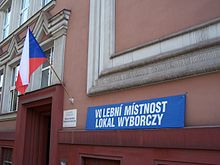
The Polish community in the Czech Republic is concentrated inCieszyn Silesia(orTrans-Olza), in the northeast of the country. It traces its origins to border changes after theFirst World Warthat partitioned the area between Poland and what was thenCzechoslovakia,leaving many Poles on what is now the Czech side of the border. The Polish population was 38,218 at the 2021 census.[18]
Denmark
[edit]It is estimated that around 40,000 Poles live in Denmark. Most live in the capital,Copenhagen.[citation needed]
Faroe Islands
[edit]Poles make up 0.2% of the population of the Faroe Islands, followed byNorwegians.[19]Most live in the capital,Tórshavn.
Finland
[edit]The history of the Polish community in Finland dates from the early 19th century when many Poles from the Russian-controlled part of the country settled there. In 1917, there were around 4,000 Poles in Finland, mostly soldiers of theRussian Imperial Army,and almost all had returned to their homeland by 1921. Some 200 Poles lived in Finland in the 1920s. Finland has never been a major destination for Polish immigrants, and only around 5,400 Poles live there. Most are well-educated: musicians, medical doctors, engineers and architects with families.[20]Around half lives inHelsinki,and the biggest Polish organization there is the Polish Association, founded on April 3, 1917.
France
[edit]
Between 500,000 and one million people of Polish descent live in France.[21]They are concentrated in theNord-Pas de Calaisregion, the metropolitan areas ofLilleandParisand the coal-mining basin (Bassin Minier) aroundLensandValenciennes.Prominent members have includedFrédéric Chopin,Adam Mickiewicz,René Goscinny,Marie Curie,Michel Poniatowski,Raymond Kopa,Ludovic ObraniakandEdward Gierek.For centuries, there was an alliance between theFranceand thePolish–Lithuanian Commonwealth:the longest-reigningqueen consortof France has been a Pole,Marie Leszczyńska.Many Poles settled in France after the rule ofNapoleonand the collapse of theDuchy of Warsaw,when 100,000 Poles, largely political refugees, fled the Russians and Prussians, who took over Poland. TheGreat Emigration,from the first half of the 19th century onwards, caused many Poles to be enlisted to fight in theFrench army.Another wave of Polish migration took place between the two World Wars when many were hired as contract workers to work temporarily in France. Polish refugees also fled the Nazi and Soviet occupations in the 1940s. From 100,000 to 200,000 Poles have been estimated to live inParis.Many EU immigrants are in southern France, including the cities ofArles,MarseilleandPerpignan.
Germany
[edit]The second-largest Polonia in the world and the largest in Europe is thePolish minority in Germany.Estimates of the number of Poles living in Germany vary from 2 million[22]to about 3 million.[23][24][25] The main Polonia organization is Kongres Polonii Niemieckiej / Polnischer Kongress in Deutschland.
Greece
[edit]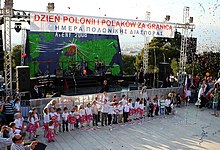
The Polish minority in Greece numbers more than 50,000, most of whom are first-generation immigrants. There might be many more since the Greek Orthodox Church administers Greek names for marriage and christening. Statistics show that over 300,000 Poles visit Greece each year for tourism, especially during the summer months. Famous people with mixed Polish and Greek ethnicity include Polish singerEleni Tzoka.[26]
Hungary
[edit]The Polish minority in Hungary is 7,001, according to the 2011 census,[27]and has a long history of over 1000 years. The Kingdom of Poland andPolish–Lithuanian Commonwealthcontained five exclaves inSpiszsurrounded by territory of theKingdom of Hungary,and following thePartitions of Poland,the Hungarian part of theAustro-Hungarian Empire(1867–1918), contained Spisz andOravawith sizeable indigenous Polish populations.[28][29]Hungary–Poland relationsare strong and positive and best described in a poem, "Pole, Hungarian, two good friends,"about the fraternal sense of commonality in both Polish and Hungarian cultures.Budapestis home to a large Polish community, and there are also ethnic Poles in the northern part of the country, borderingSlovakiaandUkraine.Most Polish-Hungarians are practisingRoman Catholics,but many are members of theEastern (Polish-Carpathian or Carpato-Ukrainian)andGreek CatholicChurches.[3]
Iceland
[edit]The Polish minority inIcelandis relatively new. As of 2019, Poles constitute roughly 5%[30]of the total population of Iceland and are, by far, the largest ethnic minority in the country.[31]
Ireland
[edit]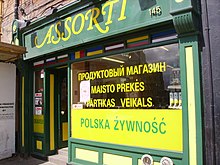
After Poland joined theEuropean Unionin 2004, Ireland immediately opened its borders and welcomed Polish workers as relatively cheap qualified labour (only the United Kingdom and Sweden did the same). Ireland quickly became a key destination for young Poles seeking work outside the country. According to the 2011 census, there are 122,585 Poles living in Ireland,[32]the largest ethnic minority in the country.
Italy
[edit]The Polish minority of confirmed status in Italy is 74,981, whereas the estimated total is 100,000, as of 2023.[33]Most Poles are late-20th-century immigrants drawn by the Italian economy's desire for imported labour. Large Polish immigrant communities are found inRome,MilanandVenice.Polish immigration to Italy might continue while the EU contract labour program between the two countries remains in place.
History of Polish migration to Italy dates back over 500 years.[33]In the 1920s, some 1,000 Poles lived in Italy, mostly clergy, artists, scholars and students, with Polish associations active in Rome andTrieste.
Latvia
[edit]Poles form about 2.3% ofLatvia'stotal population and number 51,548 people.[citation needed]They are mainly concentrated in Latvia's largest cities:RigaandDaugavpils.Since most of them don't useLatvianas their primary language their citizenship status can vary.
Lithuania
[edit]According to 2021 census, Poles are 6.52% of Lithuania's population, totaling 183,421 people[34]and over 16% ofVilniuspopulation.[35]
Malta
[edit]Moldova
[edit]
Polish presence in the territories of present-dayMoldovadates back several centuries, as the northern part of modernTransnistriaformed part of theKingdom of Polandbefore thePartitions of Poland,and thePrincipality of Moldaviawas a vassal state of the Kingdom of Poland and thePolish–Lithuanian Commonwealthat various times. The most numerous Polish communities in Moldova live in the cities ofBălți,Chișinău,Rîbnița(former Polish:Rybnica) andTiraspol.According to the 2004 census, comprising both Moldova and Transnistria, there were 4,174 Poles in the country.[36]
Norway
[edit]According to theNorwegian Statistics Bureau(Statistisk sentralbyrå), there are 137,425 Poles in Norway (2024 Official Norway estimate)[37]and makeup 2.48% of the Norwegian population. It is the largest ethnic minority in the country. Norway has recently experienced an influx of Polish migrant workers. This is because Norway is a member of theEuropean Economic Area,providing the same free movement of labour as between members of theEuropean Union.
Portugal
[edit]There are, as of December 2022, approximately 4,326PolesinPortugal,mainly recent immigrants.[38]In addition, around 300 Poles have acquiredPortuguese citizenshipsince 2008 thus making the number of Poles in the country stand at around 4,650 people.[39]Amongst the most notableLuso-Polesthere areJosé de Chelmicki,general of thePortuguese army,revolutionaryJoão Guilherme Ratcliff,architectÉtienne de Gröer,writerEsther Mucznik,intellectualMário Dorminsky,historianSamuel SchwartzandfootballerTomás Podstawski.
Romania
[edit]According to the 2021 census, 2,137 Poles live in Romania, mainly in the villages of theSuceava County(Polish:Suczawa).[40]There are even three exclusively Polish villages:Nowy Sołoniec(Soloneţu Nou),Plesza(Pleşa), andPojana Mikuli(Poiana Micului). Poles in Romania form an officially recognisednational minorityand have one seat in theChamber of Deputies(currently held byGhervazen Longher) and access to Polish elementary schools and cultural centres (known as "Polish Houses" ).
Russia
[edit]
Following thePartitions of Poland,Russia annexed the largest portion of thePolish–Lithuanian Commonwealth,and afterwards many Poles were either deported eastwards as political prisoners or were conscripted to the Russian Army, and some migrated voluntarily.
During the Second World War, the Soviet Union annexed large parts of Poland's former eastern territories ofKresy.Many Poles were expelled, but a significant number remained in what is now Belarus, Ukraine, and Lithuania. The Soviet authorities also forcibly resettled large numbers of Poles to Russia, Kazakhstan, and Uzbekistan. In Russia there are about 47,000 Poles.[3]SeePolish minority in Russiafor details.
Serbia
[edit]There is a small community of descendants ofSilesianminers inOstojićevo.[41]In the 2011 census, 741 declared themselves as Poles.[42]
Slovakia
[edit]According to the 2011 Slovak census results, there are 3,084 (0.1%) Poles living in Slovakia.[43]Compared to the Hungarian census of 1910, there has been a significant decrease, as then there were 10,569 Polish-language speakers in the territory of present Slovakia.[3]
Spain
[edit]The Polish minority in Spain numbers between 45,000 and 60,000.[44]The Polish population is mainly guest workers who took advantage of Spain's economic boom during the 1990s.Madrid,Barcelona,Seville,San SebastianandValenciahave significant Polish populations. The Polish minority in Spain is relatively young, 74% are between 20 and 49 years old.[44]
Sweden
[edit]
Like only the United Kingdom and Ireland, Sweden let Poles work in the country once Poland joined the European Union in 2004. ThePoles in Swedenhas been estimated to be around 115,985 people, 98,387 of who were born in Poland and 17,598 with both of their parents being born in Poland. Poles are thus Sweden's fifth-largest immigrant group, afterFinns,Iraqis,formerYugoslavs(Bosnians,Croats,Serbs) andSyrians.[45]Most of them are guest workers who have been invited to Sweden since 1990 by contracts with the Swedish government. Most Polish residents live inStockholm,and the rest live south of the city, toward theBaltic Sea.Historically, Poland and Sweden had some cultural exchange.
Switzerland
[edit]Like the Polish community of Finland, some Polish diasporans from Germany were come from theRhine-Ruhrbasin, as immigrant workers to Switzerland. The biggest Polish diaspora community lives in Northern Switzerland.
Turkey
[edit]In 1842, PrinceAdam Czartoryskifounded the village ofAdampolfor Polish immigrants who came to Turkey after the failedNovember Uprising.The village still exists and is now calledPolonezköy(TurkishforPolish Village). It is the main centre of the small but historic Polish community in Turkey.[citation needed]The Polish minority in Turkey has been estimated to be around 4,000 people.[citation needed]However, it is higher than the Turkish census indicates because of Turkified Poles who marry Turks. For example,Leyla Gencer's mother was Atiye Çeyrekgil, who was born Alexandra Angela Minakovska and converted to Islam after the death of her husband.[46]Also,Nazım Hikmet Ran's mother, Ayşe Celile Hanım, was a descendant ofMustafa Celaleddin Pasha,who was born as Konstantin Borzecki in 1826. He immigrated toOttoman EmpireafterGreater Poland Uprisingand embracedIslamin 1848. He later became an Ottoman General and died in 1876.[47]
Ukraine
[edit]
According to the 2001 Ukrainian census, 144,130 Poles were residing in the country.
Poles began settling in the territory of present Ukraine in the 14th century, afterRed Rutheniahad become part of theKingdom of Poland.The number of Poles in Ukraine gradually increased over the centuries, but afterWorld War II,it drastically decreased, as a result of the Soviet mass deportation of the Poles in Ukraine to Siberia and other eastern regions of theUSSRas well as a campaign of ethnic cleansing, which was carried out in the early 1940s by Ukrainian nationalists in the western part of the country (seeMassacres of Poles in Volhynia). There was aPolish Autonomous DistrictnearZhytomyrthat was created in 1926, but it was disbanded in 1935 and its Polish inhabitants were either murdered or deported toKazakhstan.The majority of those who survived the war in Ukraine were forcibly deported to theformer eastern territories of Germanyafter Poland was shifted to the west by the AlliedPotsdam AgreementafterWorld War II.[3]
United Kingdom
[edit]
It was only after theFirst World Warthat Poles settled in large numbers inLondon– many from thePrisoner of Warcamps inAlexandra PalaceandFeltham.During theSecond World Warmany Poles came to the United Kingdom as political émigrés and to join thePolish Armed Forces in the Westbeing recreated there. When the Second World War ended, aCommunistgovernment was installed in Poland and was hostile to servicemen returning from the West. Many soldiers refused to return to Poland, and around 150,000, after occupying resettlement camps, later settled in the UK. ThePolish Government in Londonwas not dissolved until 1991 when a freely elected president took office inWarsaw.

After Poland entered theEuropean Unionin May 2004, Poles gained the right to work in some other EU countries. While France and Germany put in place temporary controls to curb Central European migration, the United Kingdom (along with only Sweden and Ireland) did not impose restrictions. Many young Poles have come to work in the UK since then.
Estimates for the total number of people now living in the UK and born in Poland or of Polish descent vary significantly. There were an estimated 831,000 Polish-born residents in 2015[48]and one million by 2017.[49]Other than London, Poles have settled inSouthamptonin Hampshire,Manchester,BoltonandBuryin Greater Manchester andChorleyin Lancashire. There are also large concentrations inBradford,Leeds,CoventryandNottingham,as well as South Yorkshire, South Wales,Herefordshire,Rugby,Banbury,Slough,RedditchandSwindon.[3]
Theeconomic crisisin the UK and the growing economy in Poland reduced the economic incentive for Poles to migrate to the UK.[50]By the last quarter of 2008, it was claimed by the IPPR that up to half of those that had come to the UK to work may have returned home.[51]However, the 2011 UK Census also indicates that it was probably never true.
According to the UK Office for National Statistics, Poland had overtakenIndiaas the most common overseas country of birth for foreign-born people living in the United Kingdom in 2015.[48]
Vatican City
[edit]Although they do not settle inVatican City,the world's smallest country, many Polish priests spend time of their training studying in one of theuniversitiesof theHoly Seein Rome. The most famous Pole who settled there was, forinstitutional reasons,formerArchbishop of KrakówcardinalKarol Wojtyła, asPope John Paul II(1978–2005).
North America
[edit]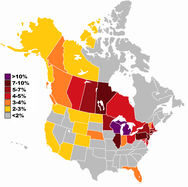

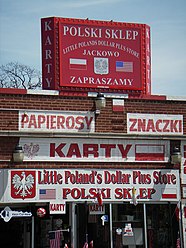
The United States and Canada were the major focus of Polish political and economic migration since 1850 up untilthe fall of the Iron CurtainandPoland’s accession into the EU.
Canada
[edit]According to theCanada 2016 Census,there are 1,106,585Polish Canadians.[52]The population is widely dispersed across Canada. The first Polish immigrants came to Canada in the 19th century. One of the largest concentrations of Polish-Canadians is in theRoncesvallesarea ofToronto.The area holds an annual Polish Festival, Canada's largest. TheCanadian Polish Congressis an umbrella organization, founded in 1944 by Polish Canadians to coordinate the activities and to articulate the concerns of the community on public policy issues.[3]
United States
[edit]There are approximately 10 millionPolish Americansliving in theUnited States.

There are approximately 185,000Polish-speakers in theChicago metropolitan area.[53]ThePoles in Chicagoare felt in a large number of Polish-American organizations in the city such as thePolish Museum of America,thePolish American Association,thePolish National Allianceand thePolish Highlander's Alliance of North America.
Pittsburgh,Toledo,Cleveland,Detroit,Grand Rapids,Minneapolis,Buffalo,Brooklyn,Milwaukee,Philadelphia,BaltimoreandNew Britainalso have very large Polish populations. Older Polish Americans are rapidly migrating to the Southeast (Florida), the Southwest (Arizona) and the West Coast (California) but also to Poland itself since the 1990s.

Buffalo is seen as Polonia's second city in the US, as it is also home to many Polish-Americans. Itssteel millsand automobile factories provided jobs for many Polish immigrants in the early 20th century. The only city to have official celebrations inspired by the popular Polish custom ofDyngus Dayis Buffalo. A section of New Britain was officially designated "Little Poland" in 2007 by a unanimous vote of the city's Common Council.
The major Polonia organization is thePolish American Congress,whose purpose is to continue steady relations with Poland anditsgovernment on behalf of Polish-Americans.[54]
Mexico
[edit]
The first Polish immigrants to Mexico arrived in the late 19th century. DuringWorld War II,Mexico received thousands of refugees from Poland, primarily of Jewish origin, who settled in the states ofChihuahuaandNuevo León.[55][56]
Haiti
[edit]About 5,000 Poles fighting in Polish Legions in the Napoleonic armies were sent to fight against the rebelling Haitians. Many of the Poles who were sent there felt it wrong to fight against the Haitians who were fighting for their freedom—just like the Poles in the Napoleonic armies—and some 400 Poles changed sides. After the war, the Haitian constitution stated that because the Poles switched sides and fought for their cause, all Poles could become Haitian citizens. Many of the Poles who were sent to Haiti stayed there. Most of their descendants live inCazaleandFond-des-Blancs.[3]
South America
[edit]There has been political and economic migration of Poles toSouth Americasince the mid-19th century. The largest number went toBrazil,followed byArgentina.[3]
Argentina
[edit]In Argentina, Poles are one of the most significant minorities, with around 2,000,000. The Parliament of Argentina has declared June 8 to be Polish Settlers' Day.[3]
Brazil
[edit]
The number of people of Polish descent in Brazil is estimated at 3 million. Most Polish Brazilians are Catholic, but there are Jews and nonreligious minorities. The oldest (1871) and largest concentration of Poles is in the city ofCuritiba,Paraná.Another large communities is to be found inRio Grande do SulandEspírito Santo.Both are in the South and Southeastern Regions.[3]
Chile
[edit]A small number of Poles came to Chile. The first came during theNapoleonic Wars.In the early 20th century, there were around 300 Poles in Chile, but they were consideredGermans.After World War II, from 1947 to 1951, around 1,500 Poles, mostlyZivilarbeitero as well as some former soldiers andNazi concentration campinmates settled in Chile, and in 1949, theAssociation of Poles in Chilewas founded.[57]An estimate of 45,000 ethnic Poles live in Chile.[58]Most live inSantiago de Chile.One of the notable Polish Chileans isIgnacy Domeyko.[59]
Colombia
[edit]It is estimated that around 3,000 Poles live in Colombia, mostly inBogotá.[60]
Uruguay
[edit]Polish immigration inUruguaybrought Poles to settle in the late 19th and early 20th centuries. An estimated 10,000–50,000 Polish descendants are thought to live in Uruguay, mostly inMontevideo,the capital. Often, Poles came when the Germans and the Russians ruled Poland and so were known as "Germans"or"Russians".[3]
Venezuela
[edit]The Polish colony in Venezuela is well dispersed throughout the country, but most of the Poles and their descendants live in big cities likeCaracas,MaracaiboandValencia.[61][62]
Oceania
[edit]Australia
[edit]
The first Polish settlers arrived inSouth Australiain 1856. AfterWorld War II,manydisplaced personsmigrated from Poland to Australia, including soldiers from thePolish Independent Carpathian Brigade(the "Rats of Tobruk"). Between 1947 and 1954, over 50,000 Polish individuals migrated to Australia, seeking refuge after many were displaced during World War II.
There are now 45,884Polish-born Australians according to the 2021 census.
According to the 2021 census, there are 209,284 Polish Australians.
New Zealand
[edit]In 1944, more than 700 Polish orphans, survivors of forced resettlement of Poles to SovietSiberia,and their caregivers were temporarily resettled at a refugee camp atPahiatua,New Zealand. It was initially planned for the children to return to Poland after World War II ended, but as they had no homes or families to return to, they were eventually allowed to stay in New Zealand after the end of the war.[63]
At the 2013 census, Polish New Zealanders numbered 1,944 by birth and 2,163 by ethnicity; of them, 42 percent lived in theAuckland Regionand 23 percent in theWellington Region.[64]
Papua New Guinea
[edit]According to estimates from 2007, some 20 Poles lived in Papua New Guinea,[65]mostly Polish Catholic missionaries and nuns, and physicians.
Asia
[edit]Armenia
[edit]The first Poles in Armenia were merchants in the 16th century, while Polish Catholic missionaries have inhabited the country since the 17th century. According to estimates from 2007, some 1,200 Poles lived in Armenia.[65]
Azerbaijan
[edit]
In nation, there is a long history of Poles in Azerbaijan (Polish: Polacy w Azerbejdżanie, Azerbaijani: Azərbaycan polyakları). However the current Polish population of the Republic of Azerbaijan is smaller than in former times, the number of people of Polish descent in Baku is around 2,000 and several thousand self-identified Poles live in Azerbaijan. Poles as an ethnic group have lived in Azerbaijan for centuries. The Russian Empire included Azerbaijan and parts of Poland during the 19th century, this was a large cause of the Polish minority in Azerbaijan.
China
[edit]
Polish presence in China dates back to the 17th century, the first Poles in China being Polish missionaries and scholars. Eventually, Poles made contributions in the fields of medicine and healthcare, developed infrastructure and industry, introducedsugar beetcultivation to China and established the country'sfirst brewery.The most vibrant Polish communities were centered inHarbinandShanghai,however, most left China after both world wars. According to estimates from 2012, some 1,000 Poles lived in China, mostly in the cities ofBeijing,Guangzhou,Hong Kongand Shanghai.[66]
Georgia
[edit]Polish presence in Georgia dates back to the 18th century. Poles made great contributions in the fields ofarchitecture,geography, arts,botanyandzoologyin Georgia. According to estimates from 2007, some 6,000 Poles lived in Georgia.[65]
India
[edit]The Indian maharajaDigvijaysinhji Ranjitsinhji,following the news of Poland being divided by theSoviet UnionandNazi Germanyat theWorld War II,had welcomed a large number of Polish refugees, mostly children. They were the first Polish group to be in India.[67]After the war, a small number of Poles decided to stay, forming the first Polish diaspora group in India.
Israel
[edit]In the early years ofZionism,Jewish immigrants from Poland (then divided betweenAustria-Hungary,The Kingdom of Prussiaand theRussian Empire) were a significant part of the ideologically motivated immigration to the thenPalestineduring theSecond Aliyaand theThird Aliyah.Many Jews of Polish origin had prominent roles in building up theYishuv,the autonomous Zionist-oriented Jewish community inMandatory Palestinefrom which Israel developed. In the aftermath of theHolocaust,manyJewish Displaced Personsin Europe who eventually got to Israel were also of Polish origin. In later generations, they generally abandoned the Polish and Yiddish languages, in favour ofModern Hebrew. About 4,000 non-Jewish ethnic Poles live in Israel. There are also about 50,000 Jewish immigrants from Poland, with an affinity to the Polish language and culture and about 150,000 of their descendants with very little of that affinity left.[68]
Japan
[edit]1,510 Poles lived in Japan, as of 2023; the majority (915) inKantō regionandTokyo.[69]
In the 1920s, some 300 Poles lived in Japan, mostly in theKarafuto Prefecture.
Kazakhstan
[edit]The first Pole to travel to Kazakhstan was probablyBenedict of Poland,sent as part of the delegation of Pope Innocent IV to the Khagan Güyük of the Mongol Empire. Later more Poles came to Kazakhstan during the Post-Soviet times. Today these Poles live in Karaganda with a population of 47,300 people.
Kyrgyzstan
[edit]Polish presence inKyrgyzstandates back to the 19th century, with the community growing from 240 in 1890 to 1,961 in 1979.[70]According to estimates from 2007, some 1,400 Poles lived in Kyrgyzstan.[65]
Pakistan
[edit]Philippines
[edit]During Spanish colonization, most Poles immigrated to the Philippines mostly for the Catholic clergy missionary work in other Asian countries. One of these Polish men wasWojciech Męcińskia Jesuit missionary fromKraków.Later on, other Poles came to the Philippines but mostly they were Polish Americans, including Michael Sendzimir, a second lieutenant who worked in the 98th Infantry Division during World War II. Today the Polish community in the Philippines has about 93 people. Some of these Poles today come to the Philippines as immigrants, ex-pats, foreign exchange students, or settled down in the Philippines by their Filipino spouses. some members of the Polish community in the Philippines, include Robert Jaworski a basketball player and an ex-senator, Zaldy Zshornack (1937-2002) and an Australian Polish man Peter Pysk founded a Polish restaurant called Babci Kuchnia. Most of the Poles live in Metro Manila, and the Polish community is the Fourth-largest Central European community after the German, Hungarian, and Albanian communities in the country.[citation needed]
Saudi Arabia
[edit]Some 500 Poles live inSaudi Arabia,mostly educated professionals, according to estimates from 2023.[71]
Singapore
[edit]Some 1,500 to 2,000 Poles live inSingapore,mostly educated employees of the maritime sector, international corporations and banks, plus scientists, according to estimates from 2023.[72]
Tajikistan
[edit]According to the 2010 census, 23 Poles lived in Tajikistan, although the diaspora was much more numerous, with over 700 people prior to theTajikistani Civil War.[73]
Thailand
[edit]In the 1920s some 20 Poles lived in Thailand,[74]a number which grew to 100 by 2007, according to estimates.[65]
Turkmenistan
[edit]Polish presence inTurkmenistandates back to the 19th century. According to the 1995 census, 501 Poles lived in Turkmenistan.[75]
United Arab Emirates
[edit]Recently there are 2,000 Poles living in UAE, the Poles came to the UAE for work. Today the Polish Community in the UAE is the largest Polish population in the Arab World.[citation needed]
Uzbekistan
[edit]
Polish presence inUzbekistandates back to the 19th century. According to estimates from 2023, some 2,000 Poles and people of Polish descent lived in Uzbekistan.[76]
Vietnam
[edit]Some 200 to 300 Poles lived in Vietnam, according to 2023 estimates, including managers, entrepreneurs and teachers.[77]
Africa
[edit]Senegal
[edit]A number of Polish missionaries worked in Senegal, starting with Jan Krzyżanowski, who lived there from 1932 until his death in 1963, making efforts to discover cures foryellow feverand other tropical diseases.[78]Further missionaries worked in service of local Senegalese communities as teachers, caretakers or directors of schools and boarding schools, nurses in clinics and hospitals, etc.[79]
According to estimates from 2023, some 55 Poles lived in Senegal.[80]
South Africa
[edit]According to the Council of Polonia inSouth Africa,25,000 to 30,000 Poles live there.[81]The Polish community in South Africa dates toWorld War IIwhen the South African government agreed to the settlement of 12,000 Polish soldiers as well as around 500 Polish orphans who were survivors of forced resettlement of Poles to SovietSiberia.More Poles came in the 1970s and 1980s, with several of them specialists coming for work contracts and deciding to stay there.[3]Magda Wierzycka,who isPolish,is the wealthiest woman inSouth Africa.[citation needed]
Tanzania
[edit]
DuringWorld War II,6,631 Polish refugees escaping theSoviet Union,including 671 men (mostly elders), 3,255 women and 2,705 children, were admitted in theTanganyika Territory(as of December 1944).[82]After the war, most Poles were repatriated to Europe, and 230 were allowed to stay.[83]
According to estimates from 2007, some 100 Poles lived in Tanzania.[65]
Uganda
[edit]During World War II, 6,443 Polish refugees escaping the Soviet Union, including 704 men (mostly elders), 2,833 women and 2,906 children, were admitted in theProtectorate of Uganda(as of December 1944).[82]After the war, the Polish refugees were gradually repatriated to Europe. In 1948, there were still 1,387 Poles in Uganda.[84]The remaining Polish refugees most likely left Uganda by 1952.[85]A preserved remnant of Polish refugees in Uganda is theOur Lady Queen of Poland Catholic Churchnear Masindi.
According to estimates from 2007, some 100 Poles lived in Uganda.[65]
Zambia
[edit]During World War II, Polish refugees escaping the Soviet Union were admitted inNorthern Rhodesia,whose number was 2,894 as of December 1944.[86]After the war, most Poles were repatriated to Europe, except for some 340 people who were allowed to stay.[87]
According to estimates from 2007, some 100 Poles lived in Zambia.[65]
Zimbabwe
[edit]During World War II, Polish refugees escaping the Soviet Union were admitted inSouthern Rhodesia,mostly inRusapeandMarondera.[86]As of December 1944, their number was 1,437.[86]After the war, most Poles were repatriated to Europe, some were relocated to Tanganyika, and some 120 stayed.[83]
According to estimates from 2007, some 800 Poles lived in Zimbabwe.[65]
List of countries by the population of Polish ethnicity
[edit]| Country | Population | % of country | Criterion |
|---|---|---|---|
| Polish in North America | |||
| 9,569,207 | 3% | ||
| 1,010,705 | 3% | Canada 2011 Census | |
| 15,000 | 0.1% | ||
| Polish in South America | |||
| 500,000 | 1.25% | ||
| 1,800,000–3,000,000 | 2.5% | ||
| 45,000 | 0.2% | ||
| 4,000–8,900 | 0.03% | ||
| Polish in Europe | |||
| 294,549–700,000 | 3.1% | ||
| 38,218 | 0.004% | ||
| 5,000 | 0.001% | [98] | |
| 1,000,000 | 2% | [citation needed] | |
| 3,000,000–5,000,000 | 4% | ||
| 9,371 | 3% |
They make them the biggest minority ethnic group in Iceland, including second-generation immigrants. | |
| 122,585 | 2.7% | ||
| 700,000–1,000,000 | 1.6% |
Poles are the largest foreign-born community in Britain [101] [102] | |
| 69,353 | 0.15% | ||
| 110,212 | 1.14% | ||
| 39,000 | 0.44% | ||
| 51,548 | 2.3% | ||
| 200,317 | 6.6% | ||
| 3,671 | 0.1% | ||
| 73,000 | 0.01% | ||
| 144,130 | 0.3% | ||
| Polish in Africa | |||
| 24,999 | 0.0001% | ||
| 25,000 | 0.042% | ||
| Polish in Asia | |||
| 5,000 | 0.001% | ||
| 5,000 | 0.001% | ||
| 5,000 | 0.001% | ||
| 7% | |||
| Polish in Oceania | |||
| 209,284 | 0.8% | ||
| 2,871 | 0.05% | ||
| Total in diaspora | ≈20,000,000 | ||
| 37,394,000 | 97% | ||
| Total worldwide | ≈56,000,000 |
See also
[edit]Notes
[edit]- ^Including 11,416 people declaring the combination of Polish and other nationality. The real number can be higher as it was possible to leave the "nationality" field blank.
References
[edit]- ^Michael Pieslak,Poles around the World (see Polonia > statystyka)
- ^Dziennikarstwa, mgr Mieszko RozpędowskiAbsolwent dziennikarstwa i komunikacji społecznej w Instytucie Edukacji Medialnej i; Warszawie, Uniwersytetu Kardynała Stefana Wyszyńskiego w.""Du ju spik ponglish"? O językowo-kulturowej hybrydzie XXI w. w wybranych przekazach popkultury "(in Polish). Archived fromthe originalon 2021-08-11.Retrieved2021-08-11.
- ^abcdefghijklmWojciech Tyciński, Krzysztof Sawicki, Departament Współpracy z Polonią MSZ (2009)."Raport o sytuacji Polonii i Polaków za granicą (The official report on the situation of Poles and Polonia abroad)"(PDF).Warsaw: Ministerstwo Spraw Zagranicznych (Ministry of Foreign Affairs of Poland). pp. 1–466. Archived fromthe original(PDF file, direct download 1.44 MB)on July 21, 2012.RetrievedMay 16,2018.
{{cite web}}:CS1 maint: multiple names: authors list (link) - ^Semen M. Dubnov; Simon Dubnow (2000).History of the Jews in Russia and Poland(Google Books).Avotaynu Inc.ISBN9781886223110.Retrieved2013-06-14.
- ^Tadeusz Piotrowski, (in English) (1998).Poland's Holocaust: Ethnic Strife, Collaboration with Occupying Forces and Genocide in the Second Republic, 1918-1947.McFarland & Company. p. 305.ISBN0-7864-0371-3.
- ^Devorah Hakohen,Immigrants in Turmoil: Mass Immigration to Israel and its Repercussions...Syracuse University Press, 2003 - 325 pages. p. 70.ISBN0-8156-2969-9.
- ^Aleksiun, Natalia."Beriḥah".YIVO.
Suggested reading: Arieh J. Kochavi, "Britain and the Jewish Exodus...," Polin 7 (1992): pp. 161–175
- ^Wilson Center, "New Evidence on Poland in the Early Cold War" By Andrzej Werblan(PDF)
- ^Tadeusz Piotrowski(1997).Poland's Holocaust: Ethnic Strife, Collaboration with Occupying Forces and Genocide...McFarland & Company. pp. 58–64.ISBN0-7864-0371-3.
- ^Andrzej Friszke,"The March 1968 Protest Movement in Light of Ministry of Interior Reports to the Party Leadership,"Intermarium 1:1 (1997, translated from Polish, originally published inWięź,March 1994).
- ^Ringer, Ronald E. (August 9, 2006).Excel HSC Modern History.Pascal Press.ISBN9780582381070– via Google Books.
- ^Encyclopedia of the Nations: Poland—Religions,available at Advameg, 2010(bottom)
- ^""Sueddeutsche Zeitung": Polska przeżywa największą falę emigracji od 100 lat ".Onet Wiadomości.September 26, 2014.
- ^"Union of Poles in Belarus".Archived fromthe originalon 2007-06-07.Retrieved2007-07-01.
- ^"The Belgian Monarchy".The Belgian Monarchy.
- ^"Population by nationalities in detail 2011 - 2020".statistiques.public.lu.Statistics portal of the Grand-Duchy of Luxembourg. 1 April 2020. Archived fromthe originalon 25 April 2020.Retrieved10 January2024.
- ^abWyszyński & Leszczyński 2023,p. 22.
- ^ab"Národnost".Census 2021(in Czech).Czech Statistical Office.Retrieved12 June2023.
- ^Demographics of the Faroe Islands
- ^Polish Embassy in Helsinki (2012),POLONIA W FINLANDII: Struktura społeczna.Ministerstwo Spraw Zagranicznych Rzeczypospolitej Polskiej.Wyróżnikiem Polonii fińskiej jest stosunkowo wysoki wskaźnik osób posiadających wykształcenie wyższe i średnie. Wśród najczęściej spotykanych zawodów występują muzycy, lekarze, inżynierowie różnych specjalności i architekci.
- ^Dembik, Christopher (4 November 2010)."Where is France's Polish Community?".The Krakow Post.Retrieved20 March2022.
- ^"Zensusdatenbank - Ergebnisse des Zensus 2011".Archived fromthe originalon 5 June 2013.Retrieved25 April2015.
- ^"Więcej praw dla Polaków, albo mniej dla Niemców".Dziennik Zachodni.October 20, 2009.
- ^""Stowarzyszenie Wspólnota Polska"".wspolnotapolska.org.pl.Archived fromthe originalon May 9, 2015.
- ^"Raport o sytuacji Polonii i Polaków za granicą 2012".Ministerstwo Spraw Zagranicznych. 2013. p. 177.Retrieved27 November2013.
- ^"The Warsaw Voice".www.warsawvoice.pl.
- ^Wyszyński & Leszczyński 2023,p. 69.
- ^Słownik geograficzny Królestwa Polskiego i innych krajów słowiańskich, Tom XV. Część II(in Polish). Warszawa. 1902. p. 414.
{{cite book}}:CS1 maint: location missing publisher (link) - ^Słownik geograficzny Królestwa Polskiego i innych krajów słowiańskich, Tom XI(in Polish). Warszawa. 1890. p. 117.
{{cite book}}:CS1 maint: location missing publisher (link) - ^"Liczba Polaków w Islandii przekroczyła 20 000 osób".News Iceland.29 August 2019.
- ^"Statistics Iceland".Statistics Iceland.
- ^"Archived copy"(PDF).Archived fromthe original(PDF)on June 5, 2012.RetrievedMarch 29,2012.
{{cite web}}:CS1 maint: archived copy as title (link) - ^abWyszyński & Leszczyński 2023,p. 72.
- ^Polacy wciąż trzymają się mocno na Litwie. Ujawniono pierwsze wyniki spisu ludności. Media Narodowe
- ^Vilnius population review
- ^"Rezultatele Recensământului Populației și al Locuințelor 2014 (RPL2014)".Rezultatele Recensământului Populației și al Locuințelor 2014 (RPL2014)(in Romanian). 2013-08-02.Retrieved2024-04-14.
- ^"Immigrants and Norwegian-born to immigrant parents".SSB.
- ^"Sefstat 2022"(PDF).
- ^"Acquisition of citizenship statistics".ec.europa.eu.Retrieved2023-05-28.
- ^"Population and housing census, 2021 - provisional results | National Institute of Statistics".insse.ro.Retrieved2024-04-14.
- ^Petrović, Momčilo (28 November 2015)."Potomci bosonogih rudara".Blic.rs.
- ^"Попис становништва, домаћинстава и станова 2011. у Републици Србији: Становништво према националној припадности -" Остали "етничке заједнице са мање од 2000 припадника и двојако изјашњени"(PDF).
- ^"The 2011 Population and Housing Census Results - Table 11 Population by nationality - 2011, 2001, 1991 (pdf - 68 kB)"(PDF).Archived fromthe original(PDF)on 2012-11-14.Retrieved2012-06-12.
- ^ab""Stowarzyszenie Wspólnota Polska"".www.wspolnota-polska.org.pl.
- ^"Befolkning efter födelseland och ursprungsland 31 december 2012"(in Swedish).Statistics Sweden.31 December 2013.Retrieved4 November2014.
- ^tr:Leyla Gencer
- ^Nâzım Hikmet
- ^ab"Poland overtakes India as country of origin, UK migration statistics show".BBC News.25 August 2016.Retrieved28 September2016.
- ^"Population of the UK by country of birth and nationality: 2017".Office for National Statistics.Retrieved26 June2018.
- ^UK Poles return home.The Telegraph. February 21, 2009.
- ^Packing up for home: Poles hit by UK's economic downturnArchived2008-10-23 at theWayback Machine,This is London, October 20, 2008,
- ^"Immigration and Ethnocultural Diversity Highlight Tables - Ethnic Origin, both sexes, age (Total), Canada, 2016 Census – 25% Sample data".25 October 2017.
- ^The Polish Community in Metro Chicago: A Community Profile of Strengths and Needs, A Census 2000 Report, published by the Polish American Association June 2004, p. 18
- ^SeeStanley S. (1976).In Quest of a Cultural Identity: An Inquiry for the Polish Community.New York, New York: IUME, Teachers College, Columbia University. ISBN ERIC ED167674.
- ^ab"Embajada de la Repùblica de Polonia en Mèxico".February 13, 2009. Archived fromthe originalon 2009-02-13.
- ^"Polacos en México, el exilio olvidado:: Noticieros Televisa".Archived fromthe originalon 2010-01-28.Retrieved2010-05-07.
- ^ab"Polemb: Actualités françaises et internationales".Polemb.Archived fromthe originalon July 24, 2011.
- ^(in Spanish)Relaciones entre Polonia y Chile. Pasado y presente, (ed.) Katarzyna Dembicz[permanent dead link]serie: Polonia y el Mundo Iberoamericano, CESLA, Warszawa, 2002
- ^"Polacos en Chile".July 24, 2011. Archived fromthe originalon 2011-07-24.
- ^Polska Diaspora na świecie,Stowarzyszenie Wspólnota Polska, 2007. Retrieved 14 August 2020.
- ^"The immigration and Polish Colony in Venezuela (Spanish)".Caracas.polemb.net. Archived fromthe originalon 2012-10-19.Retrieved2012-09-16.
- ^"Sources related to Venezuela in the archives of Poland (Spanish)"(PDF).Ikl.org.pl. Archived fromthe original(PDF)on 2013-10-23.Retrieved2012-09-16.
- ^"Pahiatua children | Polish Heritage Trust Museum".
- ^"2013 Census QuickStats about culture and identity – data tables".Statistics New Zealand. 15 April 2014. Archived fromthe originalon 15 January 2015.Retrieved28 January2016.
- ^abcdefghi"Polonia w liczbach".Wspólnota Polska(in Polish). Archived fromthe originalon 15 April 2012.Retrieved10 January2024.
- ^"Kiedyś w Chinach mieszkały tysiące Polaków, a dziś..."PolskieRadio24.pl(in Polish).Retrieved10 January2024.
- ^"During WWII, Polish Refugees Found a Home in India".28 November 2018.
- ^"Oops, Something is wrong"(PDF).www.cbs.gov.il.
- ^Wyszyński & Leszczyński 2023,p. 42.
- ^"Киргизская АССР".Demoscope Weekly.Retrieved10 January2024.
- ^Wyszyński & Leszczyński 2023,p. 14.
- ^Wyszyński & Leszczyński 2023,p. 60.
- ^Национальный состав, владение языками и гражданство населения Республики Таджикистан(PDF)(in Tajik). Vol. III. Агентии омори назди Президенти Ҷумҳурии Тоҷикистон. 2012. p. 8. Archived fromthe original(PDF)on 16 January 2013.
- ^Grochowski, Kazimierz(1928).Polacy na Dalekim Wschodzie(in Polish). Harbin. p. 155.
{{cite book}}:CS1 maint: location missing publisher (link) - ^"Итоги всеобщей переписи населения Туркменистана по национальному составу в 1995 году".Archived fromthe originalon 13 March 2013.Retrieved10 January2024.
- ^Wyszyński & Leszczyński 2023,p. 67.
- ^Wyszyński & Leszczyński 2023,p. 71.
- ^Ndiaye, Bara (2006). "Stosunki polsko-senegalskie. Stan obecny i perspektywy".Forum Politologiczne(in Polish).3.Instytut Nauk PolitycznychUniwersytetu Warmińsko-Mazurskiego w Olsztynie:198.ISSN1734-1698.
- ^Ndiaye, pp. 198–205
- ^Wyszyński & Leszczyński 2023,p. 58.
- ^""Stowarzyszenie Wspólnota Polska"".
- ^abWróbel 2003,p. 160.
- ^abWróbel 2003,pp. 250–251.
- ^Wróbel 2003,p. 249.
- ^Wróbel 2003,p. 256.
- ^abcWróbel 2003,pp. 154, 160.
- ^Wróbel 2003,p. 251.
- ^"Total ancestry categories tallied for people with one or more ancestry categories reported 2010 American Community Survey 1-Year Estimates".United States Census Bureau.Archived fromthe originalon 18 January 2015.Retrieved25 November2012.
- ^"Archived copy"(PDF).Archived fromthe original(PDF)on 2015-09-24.Retrieved2014-05-27.
{{cite web}}:CS1 maint: archived copy as title (link) - ^Statistics Canada(8 May 2013)."2011 National Household Survey: Data tables".Retrieved14 February2014.
- ^"La ampliación de la Unión Europea habilita a 600 mil argentinos para ser 'comunitarios'".27 April 2004. Archived fromthe originalon 16 May 2010.Retrieved27 May2014.
- ^Polonia w liczbachArchived2014-06-20 at theWayback MachineStowarzyszenie Wspólnota Polska
- ^ZJEDNOCZENIE POLSKIE W CHILE IM IGNACEGO DOMEYKIArchived2014-05-27 at theWayback Machine,a notice
- ^"Relaciones Polonia-Venezuela".Caracas.polemb.net. Archived fromthe originalon 2012-10-19.Retrieved2012-09-16.
- ^"Rozmowa z szefem misji dyplomatycznej Wenezueli w Polsce – Młodzi Socjaliści:" Z lewej strony "- Salon24".Mlodzisocjalisci.salon24.pl. 2011-06-24.Retrieved2012-09-16.
- ^Joshua Project."Polish of Venezuela Ethnic People Profile".Joshuaproject.net.Retrieved2012-10-05.
- ^Statistics from belstat.gov.by (бюллетень). See page 22.Archived2010-09-17 at theWayback MachineRARdata compressionof"171.5KB".
{{cite web}}:Missing or empty|url=(help)171.5KB file.Listing total population of Belarus with population by age and sex, marital status, education, nationality, language and livelihood ( "Общая численность населения; численность населения по возрасту и полу, состоянию в браке, уровню образования, национальностям, языку, источникам средств к существованию" )(in Belarusian) - ^abcdePoujol 2007,p. 92
- ^"Ausländische Bevölkerung: Fachserie 1 Reihe 2 – 2011"(PDF).Statistisches Bundesamt Deutschland. 2011-12-31.Retrieved4 January2013.
- ^"Census 2011 p. 33"(PDF).Archived fromthe original(PDF)on June 5, 2012.
- ^http://www.stat.gov.pl/cps/rde/xbcr/gus/L_Szacunek_emigracji_z_Polski_lata_2004-2012_XI_2012.pdf[bare URL PDF]
- ^"Poland's British baby boom".News Poland. 25 May 2012. Archived fromthe originalon 2 February 2014.Retrieved28 January2014.
- ^Instituto Nacional de Estadística."Polacos en España (Censo 2014)".Archived fromthe originalon 9 December 2015.Retrieved11 August2014.
- ^"Archived copy".Archived fromthe originalon April 24, 2012.RetrievedNovember 12,2015.
{{cite web}}:CS1 maint: archived copy as title (link) - ^""Szwajcaria Polakow"".szwajcaria.polakow.ch.
- ^""Stowarzyszenie Wspólnota Polska"".www.wspolnota-polska.org.pl.
- ^"Lithuania Census 2011"(PDF).Retrieved2014-05-27.[dead link]
- ^"Polska w Rumunii - Polska w Rumunii - Portal Gov.pl".Polska w Rumunii.
- ^"Всероссийская перепись населения 2002 года".Perepis2002.ru.Retrieved2012-02-05.
- ^"Results / General results of the census / National composition of population / Language composition of population".2001 Ukrainian Census.RetrievedMay 21,2011.
- ^Statistics, c=AU; o=Commonwealth of Australia; ou=Australian Bureau of."Redirect to Census data page".www.abs.gov.au.
{{cite web}}:CS1 maint: multiple names: authors list (link) - ^"Stats NZ archive website | Stats NZ".www.stats.govt.nz.
- ^Central Statistical Office(January 2013)."The national-ethnic affiliation in the population – The results of the census of population and housing in 2011"(PDF)(in Polish). p. 1.Retrieved6 March2013.
Bibliography
[edit]- Marek Żukow-Karczewski,Polonia zagraniczna w czasach II Rzeczypospolitej(Foreign Polonia during the Second Polish Republic), "Życie Literackie", No. 33, 1989, p. 10.(in Polish)
- Wróbel, Janusz (2003).Uchodźcy polscy ze Związku Sowieckiego 1942–1950(in Polish). Łódź:Instytut Pamięci Narodowej.ISBN978-83-7629-522-0.
- Wyszyński, Robert; Leszczyński, Karol (2023).Atlas Polaków na świecie(in Polish). Warszawa: Instytut Pokolenia.ISBN978-83-968580-3-0.
External links
[edit]- Reassessing what we collect website – Polish London:History of Polish London with objects and images
- Cultural Fusion: Poles in Latin America
